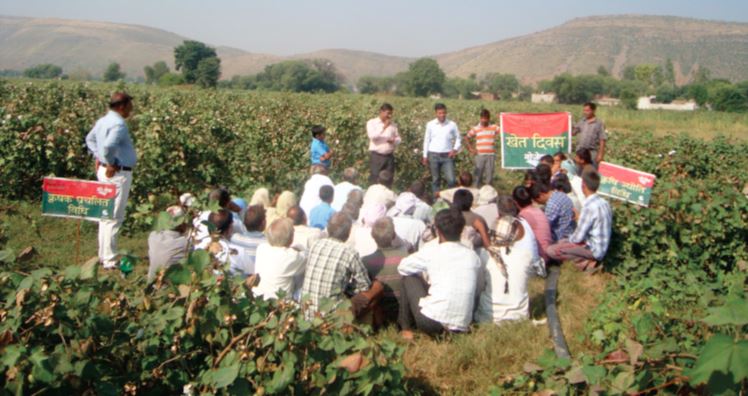 Sehgal Foundation’s Three-Pronged Development Strategy a Boon for Communities. Every person deserves to lead a more secure, prosperous, and dignified life. With that vision in mind,Sehgal Foundation is on a mission to strengthen community-led development initiatives to achieve positive social, economic, and environmental change across rural India.
Sehgal Foundation’s Three-Pronged Development Strategy a Boon for Communities. Every person deserves to lead a more secure, prosperous, and dignified life. With that vision in mind,Sehgal Foundation is on a mission to strengthen community-led development initiatives to achieve positive social, economic, and environmental change across rural India.
With support from donors and partners, Sehgal Foundation designs and promote rural development interventions that create opportunities, build resilience, and provide solutions to some of the most pressing challenges in India’s poorest communities. It works together with rural communities to create sustainable programmes for managing water resources, increasing agricultural productivity, and strengthening rural governance. The Team’s emphasis on gender equality and women’s empowerment is driven by the realisation that human rights are central to developing every person’s potential. The focus areas for interventions are: Good Rural Governance, Water Management, Agricultural Development, Rural Research and Community Media. Small holder farmers constitute the bulk of India’s agrarian population. The crucial challenge for India’s development is to ensure that these farmers are able to gain adequate remuneration from farming and contribute to the country’s growth.
“The Krishi Jyoti team stays in the village for about three years, during which time there is continued hand holding and capacity building so that the farmers and community are ready to take charge of the various interventions themselves”
Krishi Jyoti (Enlightened Agriculture) is a joint initiative of Mosaic India Pvt.Ltd., and Sehgal Foundation to provide knowledge and agricultural inputs to farmers in order to improve soil nutrition and gain better crop productivity. The initiative began in 2008 in two villages in the Nuh district (formerly Mewat) of Haryana. Within eight years, the programme has expanded to sixty villages, including interventions in water management and improvements to school infrastructure. This project now covers most of the Nuh district and some villages of the adjoining Alwar district in Rajasthan that have similar geography, climate, and cultural features. free adult movies
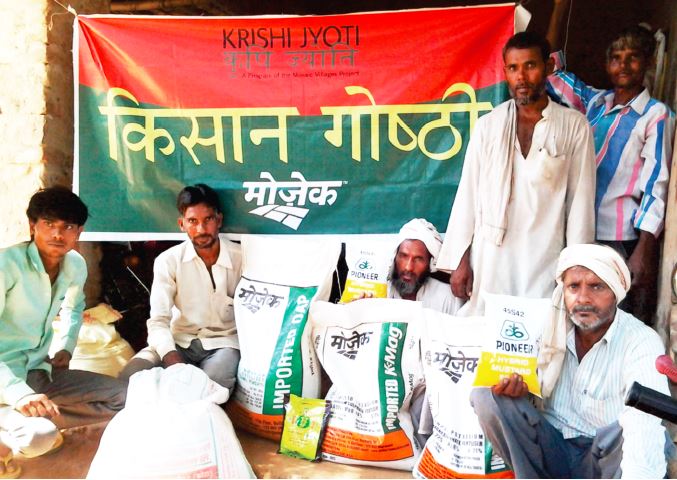 The Beginning of the Journey
The Beginning of the Journey
In 2011, Sehgal Foundation facilitated a detailed study on the backwardness of Nuh district, supported by NITI Aayog.
The study highlighted several challenges, including agriculture and water.
- About 77 percent marginal and small holder farmers are engaged in subsistence farming with landholdings of less than two hectares.Rain-fed agriculture continues to be the main source of livelihood. The average family size in Nuh villages is six members. The increase in family size with every generation, coupled with cultural traditions involving marriage and inheritance, leads to ever smaller land holdings and agricultural profits. Because agriculture is a seasonal activity, cyclical unemployment is high. Nevertheless, most of the population is still involved in farming because lack of development and industrialisation in the region offers few other employment opportunities. There is minimal migration, as education and skill levels are also low.
- Water is scarce in Nuh and rain continues to be the major source of irrigation. Only half of the area sown in Nuh is irrigated. Almost 88 percent of farmers in Nuh depend on tube wells, which have depleted the groundwater sources. High groundwater salinity is rampant in most of the villages of the district.
- The soils are deficient in most essential macro and micronutrients. Traditional fertilisers, primarily farmyard manure obtained from cattle dung, is low in supply, as animal holding is low (less than one per household). In many cases,farmers use partially decomposed manure, inviting termite attacks on crops. Chemical fertilisers, such as urea and diammonium phosphate (DAP), have been used for years in a non-scientific and uncontrolled manner. This has contributed to soil degradation in terms of nutrients, microorganisms, and physical structure. The crop rotation of wheat/mustard, followed by pearl millet, practised continuously for centuries, has also played a role in the depletion of key micronutrients in the soil. In fact, when farmers grow vegetables or mustard without fertilisers, the crops barely reach maturity.
Government- sponsored agricultural extension services rarely penetrate Nuh, leaving farmers in the district with limited or no access to soil testing or practical guidance on good farming methods, including the proper use of macro and micronutrients. These issues became the focal point for the Krishi Jyoti project. Located in the same geographical area, Alwar’s problems of salinity and lower level of water are the same as Nuh. Depletion of groundwater was significant in the State during the pre-monsoon period in 1984 to pre-monsoon period in 2002. Of the total 237 blocks, 220 blocks show a depleting trend of groundwater levels. Thus, 81.76 percent of the State was a depletion zone during this period. Depletion of water level is seen in twenty- eight districts, Alwar included, which has significantly affected agricultural development in the region. The farmers here, who mostly depend on wells and tube wells as the main sources of irrigation, have suffered a lot.
Crucial Areas of Intervention
1. Agricultural Development: Working in collaboration with farmers, Krishi Jyoti addresses three key aspects of agricultural production: soil health, agriculture inputs, and agriculture advice.
a. Soil Health: The soil condition is tested from selected farms to determine the fertiliser package to be prepared for that village. Farmers see significant increases in crop yields, and realise that with every crop, there is large depletion in the amount of nutrients in the soil, and these must be replenished to sustain the production of healthy crops.
b. Agriculture Inputs: For demonstrations, farmers are provided with quality seeds and fertilisers. The full package contains primary, secondary and micronutrients (nitrogen, phosphorus, potassium, sulphur, zinc, boron and magnesium).
c. Agriculture Advice: Farmers are provided with agronomic expertise throughout the duration of the project period and beyond, on best agricultural practices including nutrient management and pest management.
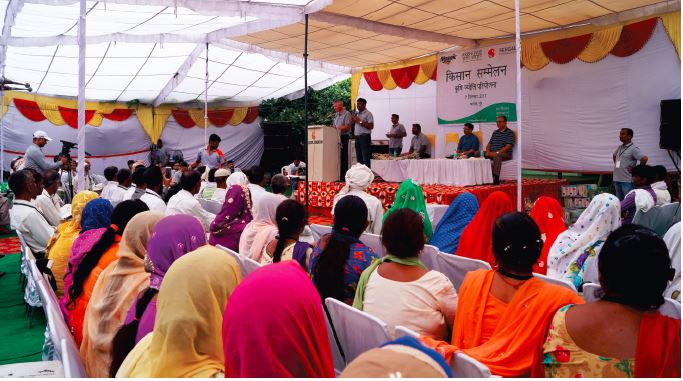 The Krishi Jyoti team stays in the village for about three years, during which time there is continued handholding and capacity building so that the farmers and community are ready to take charge of the various interventions themselves. As of 2017, thirty-six villages have graduated and twenty-four villages are still being served.
The Krishi Jyoti team stays in the village for about three years, during which time there is continued handholding and capacity building so that the farmers and community are ready to take charge of the various interventions themselves. As of 2017, thirty-six villages have graduated and twenty-four villages are still being served.
From Ferozepur Jhirka, Nuh, Punhana, and Nagina blocks of Nuh, Krishi Jyoti expanded to Alwar in 2014, and is being implemented in twenty-six villages in two blocks of Ramgarh and Bansur.
In addition to the feedback collection process by the teams, a third-party impact assessment is done to evaluate the actual success of the project. If the adoption rate in a village is less than 70 percent, the project is continued until the adoption rate increases.
“Krishi Jyoti, in synergy with State governments, has vastly improved the present body of information provided to the farmers who need it the most”
A key feature of Krishi Jyoti is the regular khet diwas (field days). For these day-long events, the farmers of the fields surrounding the demonstration plots of land are invited to see for themselves the results of adopting the recommended practices.
Krishi Sammelan is another regular. It began when the need was felt to check whether the programme had been sustained in the initial villages in all aspects: agriculture, water augmentation systems, and schools. This field event is a day-long get-together where about five progressive farmers from every village, where Krishi Jyoti has worked, are invited to the Sehgal Foundation’s field community hall. Experiences are shared, discussions are held, and two champion farmers are felicitated based on their nutrition management adoption, and being an inspiration for others.
The above mentioned table shows the increase in yield per acre for diverse crops. When farmers learn about improved farming methods, integrated nutrient management practices to sustain soil fertility, and the efficient use of water for irrigation, they are able to reap better benefits against the efforts made. With women villagers more actively engaged in agriculture-related decision making, rural farms are more productive.
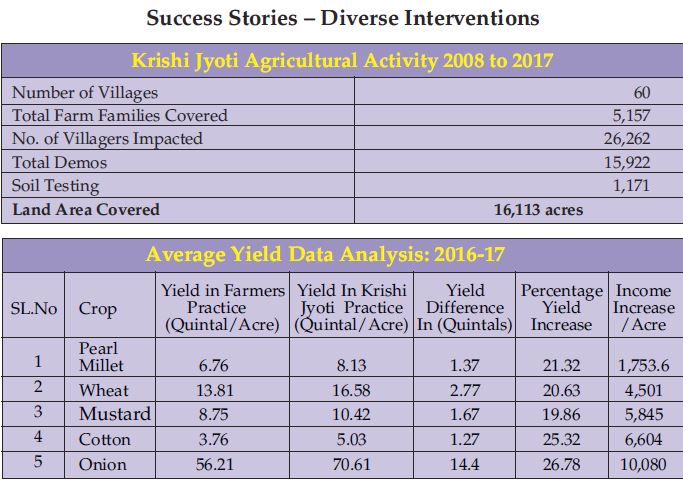 Krishi Jyoti, in synergy with State governments, has vastly improved the present body of information provided to the farmers who need it the most. Very few farmers report a need for more awareness. Adoption results in an increase in crop diversification and planting of more cash crops, thereby increasing profits.
Krishi Jyoti, in synergy with State governments, has vastly improved the present body of information provided to the farmers who need it the most. Very few farmers report a need for more awareness. Adoption results in an increase in crop diversification and planting of more cash crops, thereby increasing profits.
“I grow mustard, wheat, sorghum, millet, and vegetables. My yield for wheat has grown to 40-45 mann per acre [1mann=40kg] and mustard to 18-25 mann per acre as compared to 30-35 mann per acre and 13-15 mann per acre before. Seeing the results, I now buy the right doses of fertilisers and micronutrients for my field. Krishi Jyoti has shown us the way, and I am happy that it has led to a better life for me and my family,” says Jumme Khan, Santhawadi village, Mewat.
Shahbdeen of Niharika village, Nuh, agrees, when he adds: “I belong to a joint family of thirty members. We have eleven acres of land. I was provided training on using all the micronutrients provided by Krishi Jyoti for mustard and pearl millet. I also started using the fertilisers in wheat and vegetables and have seen an improvement of almost four to five quintals/acre. Further, the fodder quantity has increased, the seeds of pearl millet are larger, and the mustard has more oil content with shinier seeds I used the additional income to build my house and to buy a buffalo for INR 50,000.”
Says Illiyas of Niharika village, Nuh: “Iam a Meo with a family of six membersand work for the Haryana Police ASITraffic, Faridabad. I own 5.5 acres ofland. I adopted all the micronutrientsgiven by Krishi Jyoti for mustard andobserved an improvement of almostthree to four quintals/acre. Themustard crop is now more hardy and the seeds larger. The extra incomeproved useful for me to educate mychildren and also renovate my housein Ferozepur Jhirka.”
“Our objective is to encourage community mobilisation, thereby enhancing community participation and mobilisation, vital for the success of any intervention”
2. Water Management: Water is a crucial component of agriculture and has a direct bearing on the productivity and sustainability of agriculture. Krishi Jyoti promotes water conservation in villages by supporting the development of infrastructure in villages to harvest rainwater and encouraging farmers to adopt water-efficient irrigation technologies.
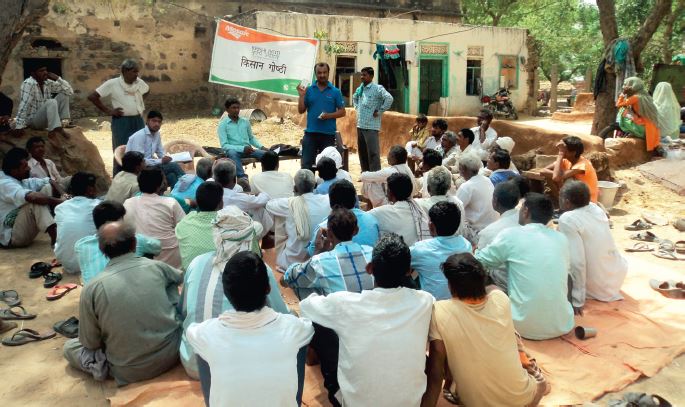 a. Water Augmentation: Improving the ground water table through the construction of check dams.
a. Water Augmentation: Improving the ground water table through the construction of check dams.
b. Water Conservation: Educating the farmers on the use of micro irrigation through sprinklers, drip irrigation, and land levelling.
In 2016, Krishi Jyoti introduced laser land levelling to farmers. This new initiative was introduced in seven demos in four villages of Alwar.
Levelling the field is basic preparation to ensure that irrigation water reaches every part of the field. Laser levelling of agricultural land is a recent resource-conservation technology. The laser-controlled land levelling equipment has shown remarkable improvement over traditional methods. The rental cost of the equipment has come down to about ten dollars for a day’s work. The benefits demonstrated include:
(i) reduction in time and water for irrigation and uniform distribution of water, (ii) precise level and smoother soil surface, (iii) a uniform moisture environment for crops, and fewer weeds in the field, (iv) good germination, growth of crop, and uniformity in crop maturity, and (v)reduced seed rate, fertilisers, chemicals, and fuel requirements.
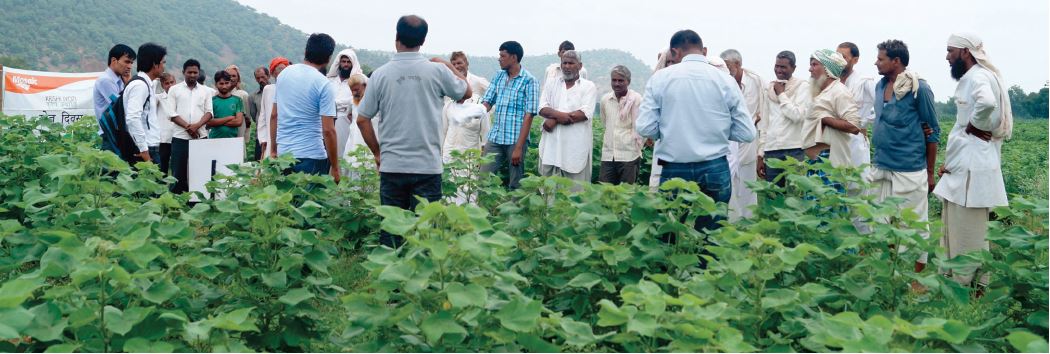 Check Dams constructed under Krishi Jyoti have helped increase the groundwater level or arrested the depletion of groundwater. These check dams are constructed in watershed areas and the ownership of the structures rests with the Panchayat.
Check Dams constructed under Krishi Jyoti have helped increase the groundwater level or arrested the depletion of groundwater. These check dams are constructed in watershed areas and the ownership of the structures rests with the Panchayat.
For the success of these projects, it is imperative for the community to develop a sense of ownership to such community-based projects. Check dams have directly and indirectly benefited more than 38,000 people, and have a total reservoir capacity of more than 16.99 million gallons, which is replenishing the underground water table.
3. Education: Helping with school renovation has increased the enrolment of children, especially girl students.
 In 2010, enhanced income, as a result of Krishi Jyoti, triggered new thoughts among the Santhawadi community, starting with the education of their children. During meetings with the Krishi Jyoti team, the residents of Santhawadi raised concerns about the poor condition of the village school. The school’s boundary wall was broken, there were no toilets, kitchen, or water supply, and the student/teacher ratio was dismally high. The villagers made an earnest request to the Team for support to help get the school into better shape. With an honest concern for the village that went beyond agriculture, the Krishi Jyoti team agreed to help renovate the school.
In 2010, enhanced income, as a result of Krishi Jyoti, triggered new thoughts among the Santhawadi community, starting with the education of their children. During meetings with the Krishi Jyoti team, the residents of Santhawadi raised concerns about the poor condition of the village school. The school’s boundary wall was broken, there were no toilets, kitchen, or water supply, and the student/teacher ratio was dismally high. The villagers made an earnest request to the Team for support to help get the school into better shape. With an honest concern for the village that went beyond agriculture, the Krishi Jyoti team agreed to help renovate the school.
The village and programme team worked together. Each village household contributed labour, and Mosaic/Sehgal Foundation shared the other costs. An external private teacher was recruited, the cost of which was covered by financial contributions from the villagers.
Subsequently, Krishi Jyoti supported the renovation of twelve more existing government schools in its project villages in Nuh and Alwar, at the request of the communities. Till date, over 3,000 children have benefited from the improvements made by Krishi Jyoti in schools.
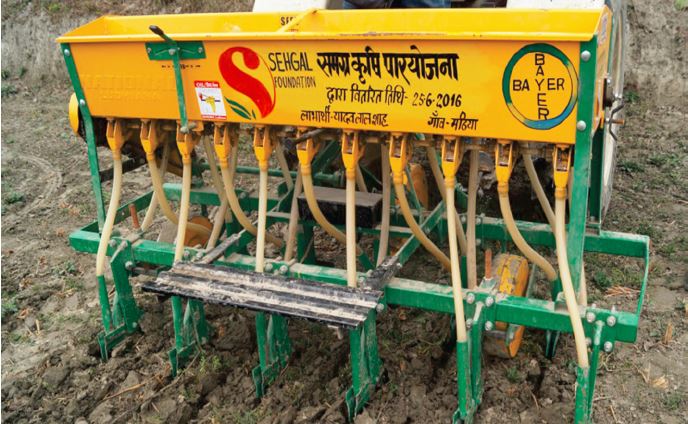 Poor literacy ratio and education are identified as the reasons for resisting change, which helps to explain the absence of basic facilities such as drinking water and separate toilets for girls, etc. Improvements made by Krishi Jyoti in the various schools include boundary wall construction, sanitation facilities (for boys and girls) with soak pits, hand-washing basins, levelling the school ground, play equipment installation, window and door repair, new maingate installation/repair, footpaths, safe drinking water facility with a force lift pump, installation of sintex tanks, repairing leaked roofs to make them risk-free, school writing board paintings, whitewashing, and walls made colourful with pictorial descriptions of various helpful themes and slogans, plantation of trees and landscaping, creation of utensil cleaning space and kitchen repairs, classroom and blackboard repairs, electrical repair work, and sufficient windows and ventilators to ensure proper inflow of natural light and proper ventilation in the classrooms.
Poor literacy ratio and education are identified as the reasons for resisting change, which helps to explain the absence of basic facilities such as drinking water and separate toilets for girls, etc. Improvements made by Krishi Jyoti in the various schools include boundary wall construction, sanitation facilities (for boys and girls) with soak pits, hand-washing basins, levelling the school ground, play equipment installation, window and door repair, new maingate installation/repair, footpaths, safe drinking water facility with a force lift pump, installation of sintex tanks, repairing leaked roofs to make them risk-free, school writing board paintings, whitewashing, and walls made colourful with pictorial descriptions of various helpful themes and slogans, plantation of trees and landscaping, creation of utensil cleaning space and kitchen repairs, classroom and blackboard repairs, electrical repair work, and sufficient windows and ventilators to ensure proper inflow of natural light and proper ventilation in the classrooms.
However, higher enrollment of students in schools is not a straightforward phenomenon even though improvements in facilities play an extremely significant role. Other factors at play include migration, inadequate number of teachers, paying capacity of parents, presence of private schools, etc. Nevertheless, an immediate spike in enrollment is always noticed in the initial years of Krishi Jyoti’s assistance with school facilities.
“I alone cannot change the world, but I can cast a stone across the waters to create ripples- Mother Teresa”
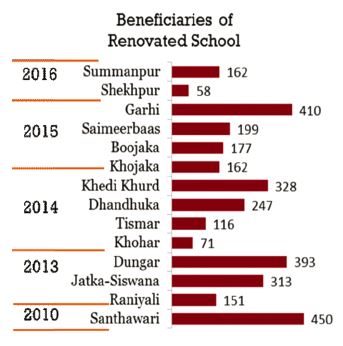 Tanya Bhatia, a Class IX student of Government Adarsh Secondary School, Village Gadhi, Ghaneta, Alwar, says, “The physical structure of our school has totally changed after the renovation work was done. Before this, there was no system for drinking water, no toilet facilities for boys and girls. The stage, classrooms and school compound were broken, and trash was scattered all over. There were no facilities available for children to play. Despite a good level of education in school, it was behind most schools in the district due to lack of proper physical structure. The compound had very few trees and plants. But since Krishi Jyoti started working in our school, it has become much more beautiful than it was before. Now our school has proper systems installed to provide clean water for children. We have swings and equipment for children to play. The school compound was levelled, and a boundary wall was constructed on all sides of the school. Plants and trees were planted, and the entire school was given a fresh coat of paint. The walls were repaired and new gates installed. The school looks clean and new now. The wonderful ambience is having a positive impact on the students. They stay longer in school and are able to study better too. More and more children from the neighbourhood have started coming to the school to study. Our school has gained a new name and recognition in the district. I thank Krishi Jyoti for doing so much for our school.”
Tanya Bhatia, a Class IX student of Government Adarsh Secondary School, Village Gadhi, Ghaneta, Alwar, says, “The physical structure of our school has totally changed after the renovation work was done. Before this, there was no system for drinking water, no toilet facilities for boys and girls. The stage, classrooms and school compound were broken, and trash was scattered all over. There were no facilities available for children to play. Despite a good level of education in school, it was behind most schools in the district due to lack of proper physical structure. The compound had very few trees and plants. But since Krishi Jyoti started working in our school, it has become much more beautiful than it was before. Now our school has proper systems installed to provide clean water for children. We have swings and equipment for children to play. The school compound was levelled, and a boundary wall was constructed on all sides of the school. Plants and trees were planted, and the entire school was given a fresh coat of paint. The walls were repaired and new gates installed. The school looks clean and new now. The wonderful ambience is having a positive impact on the students. They stay longer in school and are able to study better too. More and more children from the neighbourhood have started coming to the school to study. Our school has gained a new name and recognition in the district. I thank Krishi Jyoti for doing so much for our school.”
“I spent two years in a private school but have ultimately returned to this government school. It is much better. Our school has better infrastructure,” beamed Sachin, a student of another renovated school, with pride.
Our work is ongoing. …
Our objective is to encourage community mobilisation, thereby enhancing community participation and mobilisation, vital for the success of any intervention.
Contribution: Sehgal Foundation

